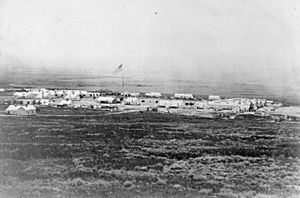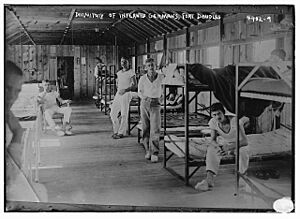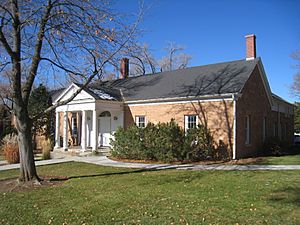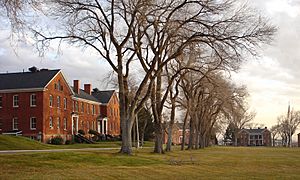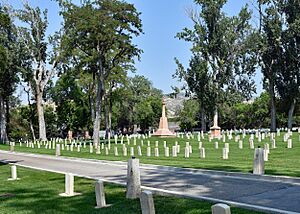Fort Douglas facts for kids
|
Fort Douglas
|
|
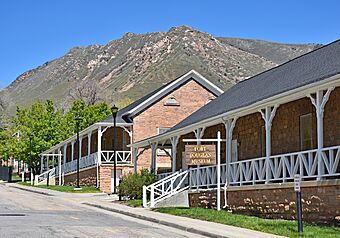
Fort Douglas Military Museum, May 2022
|
|
| Location | Salt Lake City, Utah |
|---|---|
| Area | 25 acres (10 ha) (landmarked area) |
| Built | 1862 |
| NRHP reference No. | 70000628 |
Quick facts for kids Significant dates |
|
| Added to NRHP | June 15, 1970 |
| Designated NHLD | May 15, 1975 |
Fort Douglas was once a very important military base near Salt Lake City, Utah. It started as Camp Douglas in October 1862, during the American Civil War. Its main job was to protect mail routes and telegraph lines.
Today, most of the fort's land belongs to the University of Utah. Many of its old buildings are still used by the university. You can also visit the Fort Douglas Military Museum, which is in two old barracks buildings. Fort Douglas became a National Historic Landmark in 1975. This was because of its role in the Civil War and in helping Utah grow.
The military officially closed the fort in 1991. However, a small part of it still operates as the Stephen A. Douglas Armed Forces Reserve Center. This center will fully close by 2026. After that, its land will also go to the University of Utah.
History of Fort Douglas
How Fort Douglas Started
During the early days of the Civil War, many soldiers left the western United States to fight in the east. This made people in the Utah Territory worried about safety. Colonel Patrick Edward Connor was told to bring soldiers back to Utah. He chose a spot east of Salt Lake City.
On October 26, 1862, Camp Douglas officially opened. It was named after Senator Stephen A. Douglas. Colonel Connor's soldiers were volunteers from California and Nevada. The camp became the main military base for the District of Utah.
Fort Douglas After the Civil War
After the Civil War ended, Camp Douglas became part of the Department of the Platte. Its importance grew even more in 1869. This was when the Union Pacific and Central Pacific railroads met in Utah. This event completed the First Transcontinental Railroad.
Later, thanks to Utah's U.S. Senator Thomas Kearns, the camp became a bigger military post. It was then renamed "Fort Douglas."
Fort Douglas During World War I
During World War I, Fort Douglas was used for a special purpose. It held German-American people who were interned. It also held prisoners of war (POWs) from the Imperial German Navy. One group of POWs came from a German ship called the SMS Cormoran. This ship had been in the Pacific Ocean when the war started. When the United States joined the war in 1917, the ship's crew became prisoners and were sent to Fort Douglas.
Fort Douglas Between the World Wars
In 1922, the 38th Infantry made Fort Douglas its home. They stayed there until August 1940.
Fort Douglas During World War II
After the attack on Pearl Harbor, Fort Douglas became an Army Air Field. It worked with the Salt Lake City Municipal Airport. It housed the 7th Bombardment Group and their B-17 Flying Fortress planes. Later, the Army ground forces took over the fort. This happened because people worried about a Japanese attack on the U.S. mainland.
Fort Douglas's Final Military Years
After World War II, the Army started giving away its land. Much of it went to the University of Utah, which is right next to the fort. However, the Army Reserve kept some functions there for many years. The 96th Army Reserve Command was a big part of this.
Between 1962 and 1973, Fort Douglas was home to the Deseret Test Center. This center was responsible for looking at special types of weapons. However, no actual tests were ever done at the base.
On October 26, 1991, Fort Douglas officially closed. The Utah National Guard kept control of the museum. The 96th ARCOM received the parts of the fort not given to the university.
Fort Douglas Today
Armed Forces Reserve Center
A small part of the old fort is still used by the U.S. Army Reserve (USAR). This area is called the Stephen A. Douglas Armed Forces Reserve Center. It covers 51 acres and includes the historic Soldier's Circle. The center provides offices and training space for different Army, Navy, and Marine Reserve units.
In 2023, the Utah State Legislature set aside $100 million to move the reserve center. It will move from Fort Douglas to land near the Utah National Guard’s Camp Williams in Bluffdale. A groundbreaking ceremony for the new center happened in August 2024. It is expected to be finished in 2026. Once the move is complete, the historic reserve property will be given to the University of Utah.
Commands Hosted
As of 2023, these commands are at the reserve center:
- 76th Operational Response Command
- 807th Medical Command (Deployment Support)
University of Utah Campus
In 1991, the University of Utah received a large part of the fort's land. During the 2002 Winter Olympics in Salt Lake City, much of the university's campus was used. The Olympic Organizing Committee and the university built the Olympic Village on former fort land. This village housed the athletes. Now, these buildings are homes for university students.
Stilwell Field is used as a parking lot during big events like football games. The Officers' Club building is now a conference center for the university. Several of the old officer's houses are now university departments. For example, one houses the American Indian Resource Center.
There was some discussion in 2015 about how the university was taking care of the historic fort property. It was found that during construction work, old buried items were removed and thrown away.
Fort Douglas Cemetery
A cemetery was started in 1862 about a mile south of the fort's main parade grounds. In 1864, soldiers improved the cemetery. They built a monument in the middle for soldiers who died during the Bear River Massacre. They also built a red sandstone wall around the cemetery with a steel gate. The next year, a smaller monument was added for Utah Governor James D. Doty, who was buried there.
Later, the cemetery grew to hold more burials. It included burials from Fort Cameron after that fort closed. A special section was also added for German prisoners of war who died there during World War II.
The Fort Douglas Cemetery was given to the National Cemetery Administration in 2019. The cemetery is still cared for, but no new burials are allowed. You can find a list of burials through the Utah History Research Center's cemetery database. The cemetery was damaged in a big windstorm in 2020. Strong winds knocked down large trees, which damaged headstones and other old features.
See also
- List of National Historic Landmarks in Utah
- National Register of Historic Places listings in Salt Lake City, Utah
- Camp Floyd
- List of military installations in Utah
- Statue of Patrick Edward Connor




